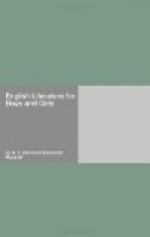But perhaps the chief interest and value of Piers Ploughman is that it is history. It tells us much of what the people thought and of how they lived in those days. It shows us the first mutterings of the storm that was to rend the world. This was the storm of the Reformation which was to divide the world into Protestant and Catholic. But Langland himself was not a Protestant. Although he speaks bitter words against the evil deeds of priest and monk, he does not attack the Church. To him she is still Holy Church, a radiant and lovely lady.
BOOKS TO READ
The Vision of Piers Ploughman, by W. Langland
Chapter XXI HOW THE BIBLE CAME TO THE PEOPLE
IN all the land there is perhaps no book so common as the Bible. In homes where there are no other books we find at least a Bible, and the Bible stories are almost the first that we learn to know.
But in the fourteenth century there were no English Bibles. The priests and clergy and a few great people perhaps had Latin Bibles. And although Caedmon’s songs had long been forgotten, at different times some parts of the Bible had been translated into English, so that the common people sometimes heard a Bible story. But an English Bible as a whole did not exist; and if to-day it is the commonest and cheapest book in all the land, it is to John Wyclif in the first place that we owe it.
John Wyclif was born, it is thought, about 1324 in a little Yorkshire village. Not much is known of his early days except that he went to school and to Oxford University. In time he became one of the most learned men of his day, and was made Head, or Master, of Balliol College.
This is the first time in this book that we have heard of a university. The monasteries had, until now, been the centers of learning. But now the two great universities of Oxford and Cambridge were taking their place. Men no longer went to the monasteries to learn, but to the universities; and this was one reason, perhaps, why the land had become filled with so many idle monks. Their profession of teaching had been taken from them, and they had found nothing else with which to fill their time.
But at first the universities were very like monasteries. The clerks, as the students were called, often took some kind of vow,—they wore a gown and shaved their heads in some fashion or other. The colleges, too, were built very much after the style of monasteries, as may be seen in some of the old college buildings of Oxford or Cambridge to this day. The life in every way was like the life in a monastery. It was only by slow degrees that the life and the teaching grew away from the old model.
While Wyclif grew to be a man, England had fallen on troublous times. Edward III, worn out by his French wars, had become old and feeble, and the power was in the hands of his son, John of Gaunt. The French wars and the Black Death had slain many of the people, and those who remained were miserably poor. Yet poor though they were, much money was gathered from them every year and sent to the Pope, who at that time still ruled the Church in England as elsewhere.




